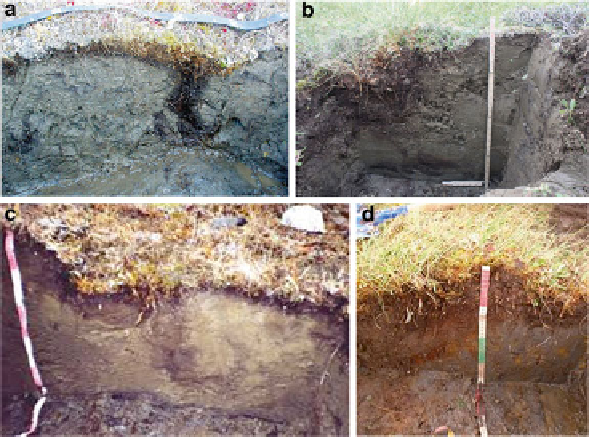Geoscience Reference
In-Depth Information
8.3
Soil Properties
As can be expected, with the wide variation in soil-forming factors across the
circumarctic, soil properties vary accordingly. Key morphological features of arctic
soils are the presence of permafrost within 1 or 2 m of the surface, cryoturbation and
cryodesiccation within the active layer, and accumulation of segregation ice in the
transient layer and near-surface permafrost. Representative profi les from arctic
Russia, Canada, and Alaska are shown in Figs.
8.2
,
8.3
, and
8.4
, respectively.
Cryoturbation is readily apparent in Figs.
8.2a-c
,
8.3c
,
8.4a
, and
8.5
. Segregated ice
can be seen in Figs.
8.3b
and
8.4b
. The presence of a shallow active layer often
results in redoximorphic conditions (Fig.
8.2d
). Figure
8.2a
shows a silt-enriched
horizon that has dilatancy, and Fig.
8.3a
shows a desert pavement and weak
cryodesiccation.
Many soils of the circumarctic are neutral to slightly alkaline (Table
8.3
); how-
ever, organic horizons and sandy podzolized soils may be extremely acid. These
trends are refl ected in the degree of base saturation. In general arctic soils have
abundant organic C in the active-layer and transition layer. Because of the high
levels of SOC and occasionally also of clay, cation-exchange values commonly are
high in arctic soils.
Fig. 8.2
Representative soils in the Russian Arctic: (
a
) Aquiturbel, northern Russia (Joint Research
Commission, EU). (
b
) Ruptic-Histic Aquiturbel, Cherskiy, Chutkotka (G. Hugelius). (
c
)
Aquiturbel, Cape Chukotskii (
http://www.arcticportal.org
). (
d
) Histoturbel (Peaty Gleyzem),
Tiksi, Russia (J. Antsibor)

